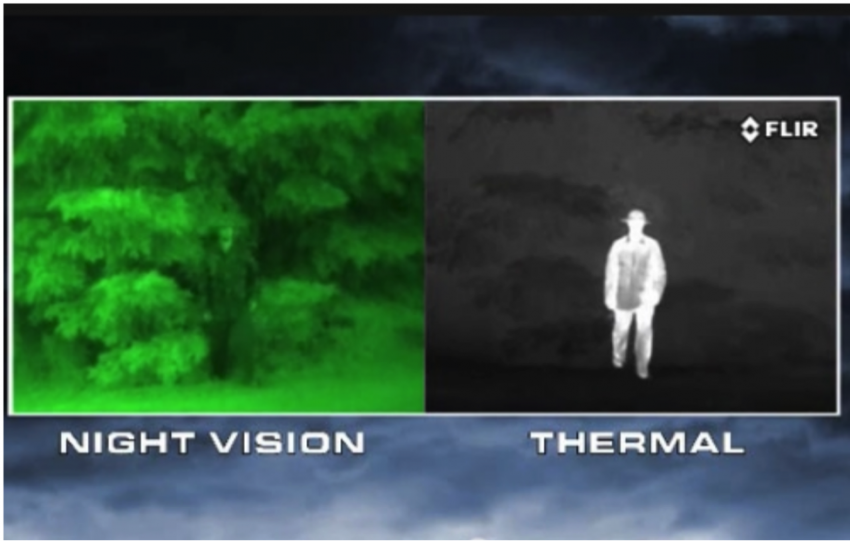
Have you ever noticed that true predators always hunt at night? This is when prey is easiest to hunt and when the predator has the greatest advantage. Evolution has taken care of the predator’s ability to stalk the dark but humans, need to seek a different route.
Technology gives us that same ability. With a little help, you can take your place as one of those predators that prowl the dark. What we are talking about here is the best night vision scopes versus the greatest thermal imaging has to offer, but which is really better for you?
The first thing we need to understand is the different technologies to decide what is best.
A Very Brief Primer
Digital night vision is the newest iteration of technology to enhance nighttime vision. This basically works like a security camera. You have a low light camera, an infrared projector, and a small LCD screen all built into a scope.
The IR reflects off different surfaces and the camera picks up that reflected light up. The result is a black-and-white image on the LCD screen. This makes up the majority of night vision technology on the market today.
Traditional night vision is a much more complicated technology that uses natural reflected light and amplifies it through a matrix. The result is a greenish-toned image that is well-known in video games and movies. When we think of night vision, this is what most people imagine.
Thermal optics use the radiant heat emitted from all warm-blooded animals to create an image. Though there are several varieties of this technology, all the models available for consumers are digital. This means it works by picking up the heat signature with a camera tuned to pick up thermal energy.
The display in a thermal imaging scope is an LCD screen and the imagery can be displayed in several ways. The most popular is the rainbow hues made famous in the movie Predator. Other modes are white-hot and black-hot which highlight heat with a single hue.
Strengths and Weaknesses
Digital night vision is the most popular because of its relatively low cost. You can get a reasonably good quality optic for less than a thousand bucks. This is very appealing for a technology that works quite well. A night vision scope is recommended when you are looking for something which enables you to have a clearer sight of objects in the dark.
The main limiting factor of digital night vision is its lack of range. While the camera detector is capable of picking up IR light at quite a distance, the projectors rarely shine more than 200 yards or so. This is a limitation of technology that will likely improve over the next few years.
When it comes to traditional night vision, you have several related but different technologies categorized into generations. The higher generations are much better but much more expensive. You can get Gen 1 night vision for under a thousand dollars but Gen 2 will run upwards of $4000-$5000 for quality units. Gen 3 increases even more, up to the price of a new car if you want to spend it.
For the cost, you do get some benefits over digital night vision. There is no restricted range due to an IR projector. The range is more limited by the transmission of visible light which can be as much as 500 yards under perfect conditions. The technology also tends to be more robust than digital night vision but has a limited life before it burns out.
Thermal is more expensive than Gen 1 or digital night vision with high-quality units in the $2000.00 range. Thermal imagining is a digital technology that has some benefits for the overnight vision that relies on IR illumination. The increased cost is somewhat justified.
The primary benefit of thermal imaging is that the range is much improved. A good scope can see in excess of 1000 yards. A downfall is that digital technology in any form is weaker than traditional night vision but a thermal scope will be on par with any digital night vision scope.
Use Considerations
If all you need to do is see in the dark at close range, any of these technologies will work. As hunters, generally for safety reasons, we won’t exceed a couple of hundred yards in the dark. But the range is hardly the only consideration.
Either of the digital technologies has the ability to record through the scope. This is a novelty but one that has become much loved by users. The better units will even start recording the moment the rifle records automatically to make use much simpler.
With night vision of either type, it can sometimes be hard to spot targets after dark at longer ranges. Thermal imaging makes targets much more apparent. With a good-quality scope, you can spot rats at ranges of a hundred yards are better. This is not possible with most night vision scopes.
With those in consideration, the most important difference is when the technology can be used. Traditional night vision can only be used when the light is not too bright. There has to be some existing light but you won’t be able to use your scope in bright lights or daylight.
Thermal and digital night vision are usable at any time of day in any light. You can use them in total darkness or the noonday sun. This makes the money you invested more worthwhile.
Final Thoughts
The only real reason for purchasing traditional night vision is as a collector. The majority of users will see little to no benefit from traditional night vision. It is an amazing technology but is becoming less common.
When it comes to thermal vs digital night vision, thermal is the better technology. It does cost several times the price but if you can afford it, get a thermal scope. If not, even a budget night vision scope will get you out in the dark and hunting. Just make sure it’s legal in your state.






